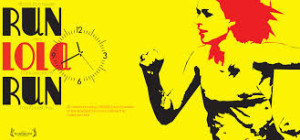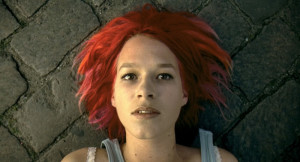Run Lola Run (1998), Rotten Tomatoes – 93%; IMDb – 7.8/10
Chapter 1: Background

Place of the film
The film is entirely shot in and around Berlin, Germany. Unlike normal movies which are shot in expensively built studio sets, this movie is majorly shot on the streets with some other set-ups including Lola’s home, her father’s bank, supermarket that Manni tries to rob, subway where Manni loses the money, a casino where Lola tries to gamble, etc. All these locations are perfectly decorated in a very much realistic way.
Purpose of the film
The film is just a piece of artistic experiment. It seems that the Writer-Director Tom Tykwer wants to try out an altogether different technique of story-telling with ‘Time’ as the chosen dimension for experimentation.
Content/narrative
The movie uses a repetitive structure that shows the course of the twenty minutes three times over. One would initially think that such a narrative structure can become monotonous but the Director smartly averts that and in fact uses it as a tool to enhance the cinematic appeal of the movie. Successful experimentation.
Chapter 2: Cinematic techniques used to achieve the director’s purpose
Space
Most of the movie is shot in the exteriors in open space. The roads of Berlin are generally very crowded. But the director here has shown calmer exteriors probably as the director’s choice of cinematic liberty in order to focus more on the hurry of its central characters.
Time
A course of twenty minutes showed thrice over signifies that this movie is an experimentation with the dimension of time. With a run-time length of 81 minutes, the movie is really fast-paced in order to showcase the unsaid central theme of ‘Hurry Up!’

The use of high key lighting in the exterior scenes increase the authenticity of the realistic sets. Low key lighting is used only in two scenes which make them stand apart in the movie questioning the believability of these scenes. One is when Lola dies after the first run & second is Manni’s after-death scene post the second run.
![[3] Red Filter](http://thclabs.org/wp-content/uploads/2015/06/RLR4-300x168.jpg)
A few other scenes with Lola & Manni together in the bed, which is essentially a visit in the past, use red filter with dim light settings. This red filter symbolizes the romance between them & the simultaneous death of one of the characters.
Chapter 3: Special effects
Color
The use of colors throughout the movie is an important part of the film. The bright red colored hair of Lola depicts
![[4] The Yellow telephone booth](http://thclabs.org/wp-content/uploads/2015/06/RLR5-300x168.jpg)
Animation
![[5] The use of animation](http://thclabs.org/wp-content/uploads/2015/06/RLR6-300x169.jpg)
Chapter 4: Sequence or aspects for study
Mise en scène
What strikes out as a peculiar aspect of Mise en scène is the color composition. The colors used for both the main characters depict strong character traits. There is not much scope to play around with costumes as the movie is spanned over just 20 minutes of a day. So the director plays more with the color and some other props like the yellow telephone booth, red telephone, roulette wheel, money bag, clocks, tattoos, etc.
![[6] Use of Clock as a repeating prop](http://thclabs.org/wp-content/uploads/2015/06/RLR7-300x168.jpg)
Cinematography & the use of sound to increase the intensity of the movie are some other aspects to be studied. The close-ups showcase the emotions of the characters & the shorter shot durations depict the rush that the characters are into.
The use of sound is also outright smart and you can hear typical sounds repeating again & again throughout the course of the movie which establishes the time loop the movie follows. Some sound effects like the scream of Lola are exaggerated but symbolize her panic. If one wishes to study how soundtrack, lyrics & music can be a perfect blend with the overall theme, this movie comes with a perfect recipe to start with.
Chapter 5: Editing
The movie uses rapid editing/fast cutting as a tool to establish the intensity & pace. Close frames in the dialog scenes help the audience in connecting the dots of the storyline. The camera & editing do not stringently follow the traditional rules but are used in a free ranging way in accordance with the experimental genre of the movie. Transition techniques like fade-in, fade-out & wipe are used at several instances. Cross-cutting and split screens are used to establish the simultaneity of events and is really effective at some places especially in the screen that shows three frames (Lola, Manni & the clock ticking).
![[7] Use of Split Screen](http://thclabs.org/wp-content/uploads/2015/06/RLR9-300x161.jpg)
Chapter 6: Verdict
Overall, this is a great movie that can be studied for its profound techniques and experimental nature that has left a mark in the history of cinema.
—
Sources: [1], [2], [3], [4], [5], [6], [7]
—
Further Tripping:
Check out the trailer of the movie to understand the importance & impact of the color scheme (Yellow & Red), clock as a prop, light effects, etc. You’d relate in a better way almost everything you just read:
 The Holy Connection An Alternative Exploration of Existence
The Holy Connection An Alternative Exploration of Existence
